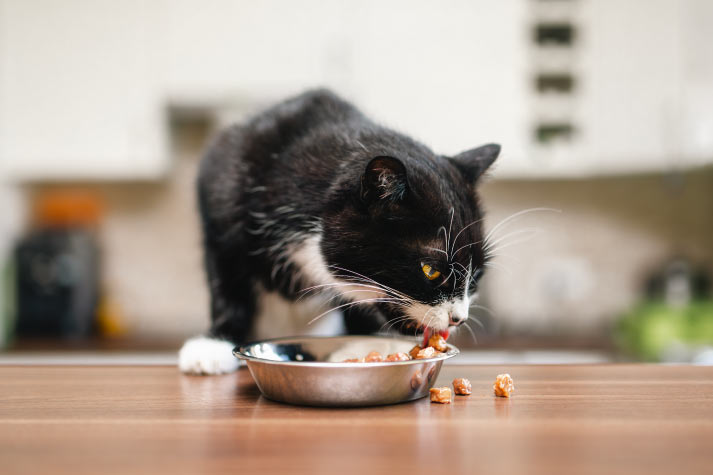


30 Apr
Feeding your cat is a core part of supporting their health, energy, and overall well-being. With the number of cat food options across shelves and aisles, it is easy to feel unsure about the different types and whether they deliver what your cat needs.
Cats are hypercarnivores, which means they rely on nutrients found only in animal-based proteins. Their bodies are not designed to handle plant-based diets, and they require specific amino acids, vitamins, and minerals that only a balanced meat-based diet can provide.

Dry food is one of the most used types, largely due to its convenience. It stores well, lasts longer after opening, and tends to be more affordable than other options. Many cat owners also appreciate that dry food does not spoil if left out, which works well for cats who prefer to graze throughout the day rather than eat it all at once. Another advantage is dental health; the crunchy texture can help reduce tartar buildup to a degree, though it is not a substitute for proper dental care.
However, dry food typically contains only around 6–10% moisture. That is an issue for cats that do not drink water frequently, which is common in indoor cats. Low moisture intake can increase the risk of urinary tract issues and kidney stress, especially over the long term. If you choose dry food, make sure fresh water is always available and that your cat is drinking it frequently.

Wet cat food contains much more moisture, usually around 70–80%. This makes it a valuable choice for cats who need help staying hydrated. It is also typically higher in animal-based protein, which lines up well with a cat’s natural dietary needs.
Wet food often appeals to picky eaters due to its softer texture and stronger smell. It can also be easier to chew, making it a good option for older cats or those with dental problems. So far, wet food sounds like the obvious choice, but it is not without its drawbacks.
Wet food is more expensive than dry food, both per serving and in overall cost. It also requires refrigeration after opening and spoils quickly if left out too long. While not as convenient, it can be an essential part of a cat’s diet, especially if you are concerned about hydration or if your cat has existing urinary or kidney issues.

Semi-moist foods sit between dry and wet in terms of texture and moisture content. They usually come in sealed pouches and have a chewy, tender feel. This makes them appealing for cats who do not like dry kibble but don’t take to canned food either.
That said, semi-moist foods often rely on added sugars, salts, and preservatives to enhance taste and shelf life. While some formulas are balanced and complete, many are better suited as treats or temporary alternatives rather than a long-term staple. They are usually not recommended for cats with dietary sensitivities or health conditions.

Some cat owners prefer to prepare food at home, often to avoid fillers or preservatives found in commercial diets. A properly formulated homemade diet allows for complete control over ingredients and can be tailored to specific health needs, allergies, or food intolerances.
But planning and feeding homemade is not as simple as cooking up chicken and rice. Cats need precise nutrient ratios, including calcium, taurine, vitamin A, and more. These are not always present in human food, and imbalances can lead to serious health problems. If you are considering this route, it is essential to work with a veterinary nutritionist to ensure the diet meets all your cat’s needs. Make sure to consult your vet regarding a homemade diet before starting it.
There is no universal “best” when it comes to cat food; your choice will depend on your cat’s age, activity level, health conditions, and preferences.
Here are some general tips:
Whichever type you choose, make sure the food is labelled as “complete and balanced” for your cat’s life stage. This means it meets the nutritional standards set by veterinary health authorities.
The right cat food does more than just satisfy their appetite; it protects health, supports longevity, and improves quality of life. No matter if it is dry, wet, semi-moist, or homemade, the key is ensuring your cat gets the right nutrients in the right amounts.
Do not hesitate to talk to your vet when switching foods or choosing a diet, especially if your cat has a medical condition or shows signs of digestive trouble. With a little attention and guidance, feeding your cat can become less of a guessing game and more of an informed choice.

AUTHOR’S BIO
ARSH BHARDWAJ
I am passionate about language, storytelling and the human urge to connect Having paid close attention to marketing and branding as a craft for some time, I'm eager as ever to indulge my passion for prose.